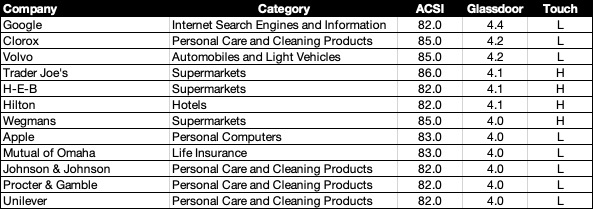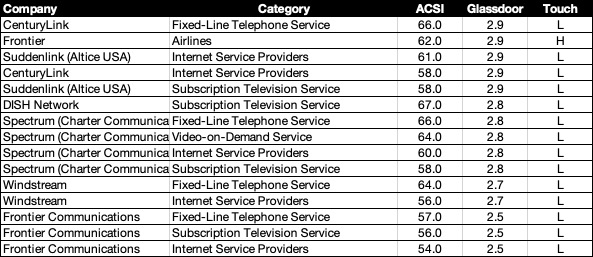The best and worst of customer and employee satisfaction (Part two in a two-part series)
And here is today’s Fake News (though the quotes are real):
“Our core values: … Put the customer first…” – Frontier Communications website
“We take pride in knowing how to take care of you.” – Message to potential employees on the State Farm website
“Our team members are the key to our success. Whether they work behind the scenes or are out there delivering great service to our guests.” – Frontier Airlines website
This is the second article about the results of my third annual study of the relationship between employee and customer satisfaction. The first article is here. This time I will cover love and hate, stars and goats. (What a program!)
Love-hate relationships
Here are the companies whose employees love them while their customers hate them. From a data perspective, this means they are in the top 10% of the Glassdoor scores while being in the bottom 10% of the 398 ACSI scores. There are just four companies in this category:

Should we be surprised by the positions of the three social media businesses here? Great employment conditions and the fact that the customers seem to hate them is not really a major source of concern. We could debate whether the US consumers answering the ACSI feedback requests are actually the customers. After all, the companies’ main source of income is from advertisers, who were not asked. As for United Airlines, I think the few high-profile nasty incidents they had with passengers last year and in 2017 made a difference to perceptions. They had the biggest drop of any airline. My prediction is that it will all be forgotten in 2019 and they will have the biggest improvement.
And there is just a single company in the opposite category. Kraft Heinz employees give them an appalling Glassdoor score of 2.9, while customers give them an ACSI score of 82. I think it is safe to say that Kraft Heinz employees have a lot to deal with these days and never come into contact with end consumers.
Companies that seem to get everything right – The heroes
Yes, they exist. Here are the companies that are in the top 10% on both the ASCI and Glassdoor lists:

Note that the list is in the order of the Glassdoor rankings. Hilton topped the ACSI list for hotels for the fourth year in a row, and their employees love them too. Do you see anything surprising here? I don’t.
Companies that seem to get everything wrong – The goats
Personally, I think goats are cute and I am not sure why various BCG-style business models cast them as the villains. Anyway, here are the companies that managed the difficult task of being in the bottom ten percent for both their customers and their employees:

Should we be surprised to see the lower table almost exclusively populated by ISPs and TV service providers? I think not. Telecommunications companies have a reputation for disdain of both customers and employees.
Are these comparisons fair?
No, the comparisons are not fair, at least as far as customer satisfaction is concerned.
Customer satisfaction varies strongly by industry. There are industries, such as telcos, cable TV companies, and Internet Service Providers, that have little or no opportunities to ‘delight’ us. If they do their jobs perfectly, we simply don’t notice them. We only notice them when things go wrong. So it is to be expected that they would do relatively poorly in customer satisfaction comparisons that cross industry lines. However, that is no reason for them to treat their employees badly.
Conclusion
We should not find the lack of a strong relationship between employee and customer happiness very surprising, for two main reasons. First, a company’s products and services are generally far more important to customers than the employees. The main exception to this rule is where the employees are the product. Second, employee happiness and employee engagement are two quite different concepts. Employees can be happy with their pay, the food in the company restaurant, and their commute to work. None of these do anything for customers.
Employee engagement is a more sophisticated concept that lacks a standard definition. When I worked at HP the Employee Engagement Index was an aggregate of nine questions. Other companies use different standards, as does every study I have read on the subject. (For the experimental scientists among you, this smells of ‘p-hacking’. Ask a lot of questions in your employee survey. Determine after the fact which set of ten have the best correlation with revenue growth. Combine them in some way and call that your ’employee engagement index’. That’s cheating!)
Data
I have put an Excel sheet with the data here. There are four tabs. It is not very pretty. I have inspected it in various ways but may still have made some sort of error. If you find one, please let me know.
If you enjoy this sort of thing, there is lots more on this topic and many others in our book Customer Experience Strategy – Design and Implementation. All of our books are available in paperback and Kindle formats from Amazon stores worldwide.





September 11, 2019 @ 6:31 am
Hmm… I would welcome a pointer to Forbes research on the topic. I can’t find it. The Forbes article below, for example, does not mention a source for its conclusions.
https://www.forbes.com/sites/ashiraprossack1/2019/05/31/employee-satisfaction-customer-satisfaction/
The recent Economist article on the subject used identical research methods to mine, but of course 2.5 years later.